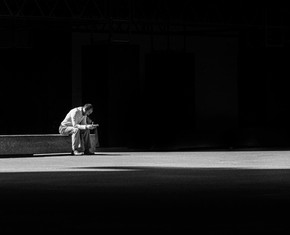The views expressed in our content reflect individual perspectives and do not represent the authoritative views of the Baha'i Faith.
Everything grows, matures and dies. If you want to see the whole cycle, go to any hospital. First, check out the maternity ward, then visit a few terminal patients.
When we really pay attention, that remarkable juxtaposition of birth and death, all in the same place—the tremendous, universal cycle of life—can help us understand our own spiritual search.
For years I worked in hospitals, and I never got tired of the miracles I witnessed there. The maternity wards, among the most joyous places on Earth, welcome new babies into the world every day. Those births cause enormous celebration and happiness, bathing everyone who visits in smiles. Walk a few feet, take an elevator or climb the stairs, and you can see people in the midst of their transition to the next phase of existence, ready to leave this world and go on to the next. Yes, you’ll encounter much sadness and many tears in those rooms, from families and friends going through great loss, but you’ll also see, if you look hard enough, the preparation for a second birth, for that spiritual journey into whatever waits for us on the other side of dying.
So just as this physical life exemplifies the power of growth and maturation—of the irresistible, built-in, genetic drive of all living things to continually transcend one state of existence and gradually move toward the next—our individual path to spiritual maturity does exactly the same thing. Just as physical life has stages of development—infancy, childhood, adolescence and adulthood—our spiritual life progresses through similar stages, too.
Since even the tiniest form of life starts out as a tinier seed that contains its own genetic code, we all mature through time into the fulfillment of that code. Everything physical, in our entire universe, grows and develops that way. One egg and one sperm become a fetus, and then a baby, and then you. A tiny seed becomes a mighty sequoia. A star is born in the gravitational collapse of a gaseous nebula; flames its plasma into being and burns brightly for millions of years; spins off, supports and sustains its solar system; and then finally exhausts its fuel into interstellar gas once again.

All of us have those built-in, pre-programmed stages of growth, both physically and spiritually, kneaded into our very beings. Our DNA regulates that growth, and requires it to go through a succession of pre-planned phases. This may seem obvious, but think about it for a moment, and realize the miracle it represents: you share, with all other life forms, one consistent, universal pattern of maturation and growth. The timeframe may change and the materials may be different, but everything evolves through its lifetime in the same exact way, according to a harmonious pattern nature repeats everywhere.
Need proof? Take a look at yourself in a mirror. If you’re an adult whose physical growth has peaked, you may think of your body as something fixed and relatively constant, but that’s only an illusion. In fact, adult bodies renew each cell—except the neurons of the cerebral cortex, the inner lens cells of the eye, and muscle cells of the heart—every 7-10 years. You might think of your own body as permanent and fixed, but it actually grows and changes in a state of constant flux, rebuilding itself every second, discarding old cells and making new ones. For example: your entire epidermis—the surface of your skin—recycles every two weeks or so. The cells that line your stomach live for about five days. In adults, every bone entirely replaces itself about once a decade. Each red blood cell lives for approximately 120 days. The adult liver completely replaces itself every 12-18 months.
All of this perpetual motion—the constant rebuilding of our bodies, along with our digestion, our breathing, the pump and flow of our lifeblood, the continual charges of electricity inside our nervous system, the twitch of muscle on bone—defines what it means to be alive. In the same way, individual atoms never rest, because electrons and protons spin around nuclei like miniature earths and suns. Molecules remake themselves. Cells divide and multiply, battle disease, strengthen sinew, heal wounds, each contributing to the growth and development of the whole. This cyclical process of motive maturation forms the basis of all life. Study it, and you will discover a profound spiritual truth:
The elemental atoms which constitute all phenomenal existence and being in this illimitable universe are in perpetual motion, undergoing continuous degrees of progression. – Abdu’l-Baha, The Promulgation of Universal Peace, p. 284.
Just as being in motion is the test of life, so being stationary is the test of death and when a moving object stops it retrogrades. To stop means to fall. When a tree stops giving fruit it decays. In other words, man must throughout all the degrees of life evolve and progress day unto day, for life is continuous. – Abdu’l-Baha, Divine Philosophy, p. 124.
Our physical bodies, if we pay attention, can teach us that spiritual truth—evolution and progression take place in our minds and spirits just as they do in our cells. Life continues, always, so our duty and challenge and privilege as people means maturing physically and maturing spiritually.
For millennia, the world’s most renowned philosophers have told us all this, beginning with Socrates and Plato; and every great religious teacher from the earliest to the most recent—they all affirm that the entire, ever-growing physical creation itself forms one gigantic parable, created to continually teach us about our innermost reality. In one sense, the physical world exists to tell us about the spiritual world.
When you really pay attention, you see this daily miracle everywhere you look. The unfolding flower, the green sprout, the brightening dawn, the ripening fruit, the fragrant springtime and the new baby, each beautiful in its own right, all have another level of beauty that goes beyond the physical. They each symbolize the power of maturation, conscious spiritual growth and newly-realized inner life.
Amidst all this motion and growth, the Baha’i teachings offer a uniquely insightful, powerful reservoir of knowledge, wisdom and guidance for human spiritual development and maturation. In this series of essays, we’ll explore two of Baha’u’llah’s most mystical books, The Seven Valleys and The Four Valleys, and examine how they answer the most important human questions: What character traits and virtues define a truly spiritual person? How can my soul grow, develop and mature? Which spiritual path can I take to prepare me for this life—and the next one?
You May Also Like
Comments

















We might be so close to it but still moving towards it.
The capacity and capability are cxc or c squared which could be as thimble full, cup, or gallon measure.
Just be!